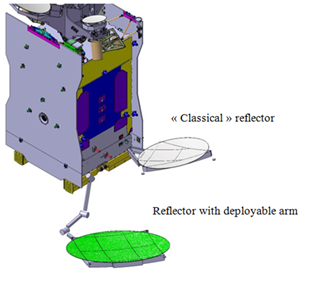
-
StatusCompleted
-
Status date2016-07-20
-
Activity Code5A.045
Multibeam Telecom satellite missions with small beams up to Ka band require large aperture antennas with increased focal length and/or large reflector clearance.
To achieve this goal, an Antenna Deployment and Pointing System (A-DPS) is required. The study objective is to assess the reflector assembly dynamic and kinematic impacts at satellite level on pointing performances, considering DPS solutions and define the most efficient architecture and product evolutions for Antenna Tracking System (ATS) to meet the mission pointing requirements.
In relation with ATS evolutions, the feasibility of upgrading the actuation chain HW at MPIU level is investigated with a dedicated breadboard.

Competitiveness is a key driver to successfully embark Antenna Deployment and Pointing System (A-DPS) and Antenna Tracking System (ATS) product. Consequently, the study focuses on architecture and products providing the most attractive recurring cost.
Mechanical instabilities are expected for the ATS product when applied to an antenna equipped with A-DPS. Additionally, new flexible modes (over larger band) and mix of flexible modes are expected when several antenna types have to be handled with ATS on the same satellite (e.g. some antennas with boom and some without boom).
The study investigates on this DPS/ATS feasibility and compatibility demonstration, with simulations to define and tune specific ATS software adaptions, and check at hardware bench level that increased actuation chain rate is compatible with Antenna Deployment and Trimming Mechanism (ADTM) behaviour.
Extended arms for reflector antennas provide greater off-set and more room for additional equipment to be placed on e.g. the top of the satellite.
The arms equipped with mechanisms allow large antenna stowing on the platform and provide long focal or clearance in deployed position. This solution provides a breakthrough with respect to the current limit for focal length with available platforms, below 4 meters, to respond to the new need coming from current RFPs, up to 5 meters.
The adaption of Antenna Tracking System (ATS) to A-DPS is the enabler towards an efficient and cost effective solution to meet mission pointing requirements, aiming at least the current ATS Mk1 performances with global pointing performance of 50mdeg half-cone worst case.
An Antenna DPS is in development at Airbus D&S Netherlands under ARTES 5.2 contract. CDR was held in April 2015.
ATS Mk1 is presently operational in Ka-Band on two commercial telecom spacecraft, with on-board receivers, for antennas with main flexible mode frequency above 1.2 Hz, driven by specific stepper motors (small steps of typically 2.5 mdeg). Ground based ATS is also operational in L-Band large aperture antenna with Alphasat XL. The present study makes best use of above technologies for selected missions with A-DPS.
The development investigates the most efficient share of ATS functions and hardware between the space segment and the ground segment, to obtain satisfactory antennas pointing performances, with the highest cost efficiency.
The project started in October 2015. Its duration is 18 months. The project milestones comprise a Kick-Off Meeting (KOM), a Baseline Design Review (BDR), a Mid-Term Review (MTR), and a Final Review (FR).
Final review held in November 2017.



